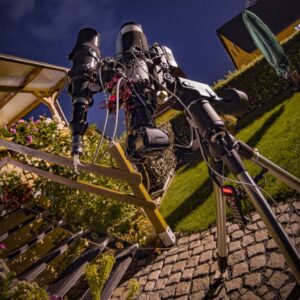This site contains affiliate links to products. I may receive a commission for purchases made through these links.
There’s something truly magical about watching a meteor shower. It’s a celestial spectacle that never fails to inspire awe. But how do you know when to watch? And what’s the best way to do it? That’s what I’m here to help with.
Meteor showers aren’t as mysterious as they might seem. In fact, they’re pretty predictable. With a bit of knowledge and planning, you can have a front-row seat to one of nature’s most breathtaking shows.
In this guide, I’ll share my top tips for spotting meteor showers. From the best times to watch, to the gear you’ll need, I’ve got you covered. So stick around, and let’s dive into the world of meteor showers.
When to Watch Meteor Showers
Timing is crucial when it comes to spotting meteor showers. But luckily, there’s a science behind predicting the best times to do so. Meteor showers occur regularly throughout the year, with each shower having its own period of maximum activity. Peak meteor shower times are often listed in astronomical almanacs or reputable astronomy websites.
Meteor showers typically peak after midnight, when the side of the Earth you’re on is heading directly into space debris. In other words, after midnight is usually the best time to watch a meteor shower. Another pro tip – meteor showers are more vivid the further away you are from urban light pollution.
It also helps to understand that meteor showers often last for days. So, even if you’re unable to watch at the predicted peak time, don’t worry. There’s a good chance you’ll still see a fair amount of activity on the surrounding nights.
It’s key to note that weather plays a major role in visibility. Unobstructed clear skies are ideal, but not always guaranteed. So, always have a backup plan in case weather conditions are unfavorable.
If you’re dealing with time constraints or adverse weather, an online meteor shower radar can be a handy tool. These online resources offer live tracking and predictions of meteor showers, so you can plan your viewing accordingly.
While specific dates vary from year to year, some meteor showers prove reliably spectacular. Here is a markdown table of Annual Meteor Showers and their general peak dates:
| Shower Name | Peak @ |
|---|---|
| Quadrantids | January 3-4 |
| Lyrids | April 22-23 |
| Perseids | August 12-13 |
| Orionids | October 21-22 |
| Leonids | November 17-18 |
| Geminids | December 13-14 |
The anticipation and excitement of a meteor shower is a unique experience that’s truly out of this world. With the right timing, preparation, and a bit of luck from Mother Nature, it can be an unforgettable spectacle. The tips shared above should come in handy for your next meteor shower viewing adventure.
Where to Watch Meteor Showers
After understanding when to catch these dazzling spectacles, the next essential piece of the puzzle is figuring out where to watch meteor showers.
Optimal viewing locations vary with individual circumstances. However, the overriding advice I can give is that you’ll want to find a spot as far from city lights as possible. Artificial light pollution greatly reduces the visibility of celestial events. The fewer the lights, the more meteors you’ll likely see.
A clear, open sky is key. Places with wide, unobstructed horizons give the best views. Consider locations such as public parks, beaches or perhaps even a friend’s backyard in the countryside. What you’re looking to avoid are places surrounded by tall buildings or dense trees that might block parts of the sky.
It’s also worth mentioning that meteor showers aren’t just an event for a tiny window in the middle of the night. Remember, showers can last for several days. Even if you can’t find the ideal location for the peak viewing time, don’t let that dissuade you.
Weather is another crucial factor to consider. Even the most spectacular meteor shower can’t punch through a thick cloud cover. Stay abreast of the weather forecasts around expected peak times. Fast-changing weather patterns might necessitate a Plan B if your original viewing spot clouds over.
Preparing a comfortable viewing setup is equally important. A lawn chair, cozy blankets, hot drinks or snacks can make all the difference during potentially long periods of stargazing.
Lastly, remember to turn off all lights, including your smartphone. It might take your eyes up to thirty minutes to fully adapt to the dark, but it’s worth it when that brilliant comet dances across the darkness.
In the coming section, we’ll dive into how to identify different meteor showers, so you know exactly what you’re looking for.
Understanding Meteor Showers
Simply put, meteor showers are a celestial event where numerous meteors or “shooting stars” can be seen streaking across the night sky. These events are caused by streams of cosmic debris entering Earth’s atmosphere at extremely high speeds, creating a spectacular light show.
So, where does this debris come from? Most of it’s from comets, which are essentially “dirty snowballs” composed of ice, rock, and other materials. As comets traverse through space and get closer to the sun, they warm up, and the ice starts to vaporize. This process causes the comet to shed some of its material, leaving a trail of debris in its path.
Meteor showers take their names from the constellation where they appear to be coming from. Let’s take the Leonid meteor shower, for instance. It’s named after the constellation Leo because the meteors seem to originate from that region of the sky. It’s important to note that the constellation merely provides a direction for these meteors and is not the actual source of the meteor shower.
When Earth travels through the debris trail left by a comet, that’s when we get to witness a meteor shower. Those bits and pieces burn up as they enter the Earth’s atmosphere, creating bright streaks of light visible from the ground.
There’s another consideration to make while watching for meteor showers – the Moon. The best time to observe a meteor shower is when there’s little or no moonlight to interfere. That’s usually around new moon phases or when the moon has set for the night. The less moonlight, the darker the skies, and the more meteors you’ll be able to see!
So, as a budding stargazer, these are the basics you need to know. Following sections will delve into further aspects of meteor watching, such as the meteor shower calendar for the year, and helpful apps and equipment to aid your observations.
Best Meteor Showers of the Year
Many meteor showers light up the Earth’s night sky throughout the year, each offering a unique spectacle for the avid stargazer. Perseids, Orionids, Leonids, and Geminids are among the most prolific meteor showers. Before diving into the specifics of these showers, it’s crucial to understand that the best time to observe any meteor shower is when it’s at its peak.
Perseids in mid-August is arguably the most popular meteor shower. It’s well-loved for its consistently high rate of meteors and spectacular fireballs. It originates from the Swift-Tuttle comet and radiates from the constellation Perseus.
Following Perseids, the Orionids peak around late October. Named after the constellation Orion from which it appears to come, the shower is associated with the famous Halley’s comet.
Mid-November brings the Leonids, a meteor shower that’s become known for its periodic storms. The meteors from this shower are incredibly fast and often leave persistent trains behind them.
Rounding off the year, Geminids peak in mid-December. Unlike most meteor showers which originate from comets, Geminids originate from an asteroid: the 3200 Phaethon.
| Meteor shower | Peak | Source |
|---|---|---|
| Perseids | Mid-August | Swift-Tuttle comet |
| Orionids | Late October | Halley’s comet |
| Leonids | Mid-November | Tempel-Tuttle comet |
| Geminids | Mid-December | 3200 Phaethon asteroid |
In the next section, I’ll be covering the best practices to observe these celestial events effectively – including suggested apps and equipment to enhance the viewing experience.
Gear for Watching Meteor Showers
Spotting meteor showers requires patience, skill, and the right equipment. While it’s true that you can enjoy a meteor shower with just your naked eye, having a few essential gear items can enhance the experience.
First on the list are binoculars. While they’re not necessary, they can help you see more details and cover a larger area of the sky. You don’t need any high-powered, complex binoculars. A good set with 7×50 or 10×50 specification is enough. Another crucial piece of equipment is a comfortable lawn chair. Trust me, neck strain is a very real threat for stargazers!
Another consideration is clothing. The coolest meteor showers strike during chilly seasons, so dressing warmly cannot be overstated. Layers are your friend when it comes to staying warm, and don’t forget hats, mitts, and thermal boots. Consider bringing along a thermal blanket or sleeping bag for additional warmth as well.
Next, let’s not forget snacks and beverages. They can make the waiting game much more enjoyable. Just remember to choose food and drinks that won’t distract you too much from the sky watch—easy-to-consume and less messy items are the best.
Finally, consider using a stargazing app on your smartphone. This can help you locate constellations, identify individual meteors, and even learn more about what you’re seeing. Some popular stargazing apps include SkyView, Night Sky, and Stellarium. With these tools, you’ll be able to identify the meteors’ paths and know exactly where to look.
Last but not least, bring a flashlight, preferably one with a red filter to preserve your night vision. You’ll need it for safety reasons and to see your gear, but you don’t want it to interfere with your stargazing.
Remember, the goal here is comfort and preparation. While it’s easy to get excited about the spectacle, ensuring you’re properly geared up can make the experience much more rewarding. So, gear up, get cozy, and let the sky show begin!
That’s it for the essential gear for watching meteor showers. In the next section, we’ll talk more about the science behind meteors and meteor showers and how these incredible celestial events are formed.
Conclusion
So, there you have it. Watching meteor showers isn’t just about looking up to the sky, it’s about understanding their origins, knowing the best times to watch, and being well-prepared. Remember, meteor showers are named after constellations, not sourced from them. And the less moonlight, the better your view will be. Keep an eye out for the Perseids, Orionids, Leonids, and Geminids showers, they’re truly a sight to behold. Don’t forget your essential gear either – binoculars, a comfy lawn chair, warm clothes, and snacks. A stargazing app and flashlight can also come in handy. With the right knowledge and preparation, you’re all set for an unforgettable meteor shower watching experience. Happy stargazing!
What are meteor showers?
Meteor showers are caused by streams of cosmic debris entering Earth’s atmosphere at high speeds.
Where does the debris from meteor showers come from?
Most of the debris that forms meteor showers comes from comets.
How are meteor showers named?
Meteor showers are typically named after the constellation from which they appear to originate. However, this constellation is not the actual source of the meteor shower.
Does moonlight affect the visibility of meteor showers?
Yes, less moonlight allows for better visibility of meteor showers.
Which are the best meteor showers of the year to watch?
The most notable meteor showers of the year include the Perseids, Orionids, Leonids, and Geminids.
What is the essential gear for watching meteor showers?
Essential gear for watching meteor showers includes binoculars, a comfortable lawn chair, warm clothing, snacks and beverages, a stargazing app, and a flashlight.
Why is comfort and preparation important when watching meteor showers?
Comfort and preparation are key to having a rewarding experience when watching meteor showers. It allows you to focus on the experience rather than physical distractions.



